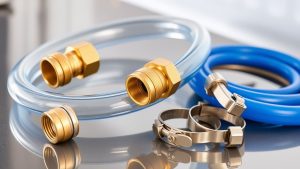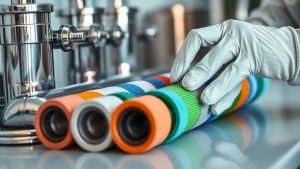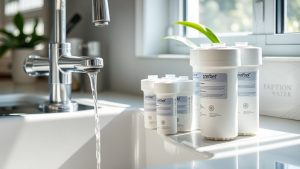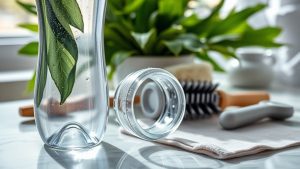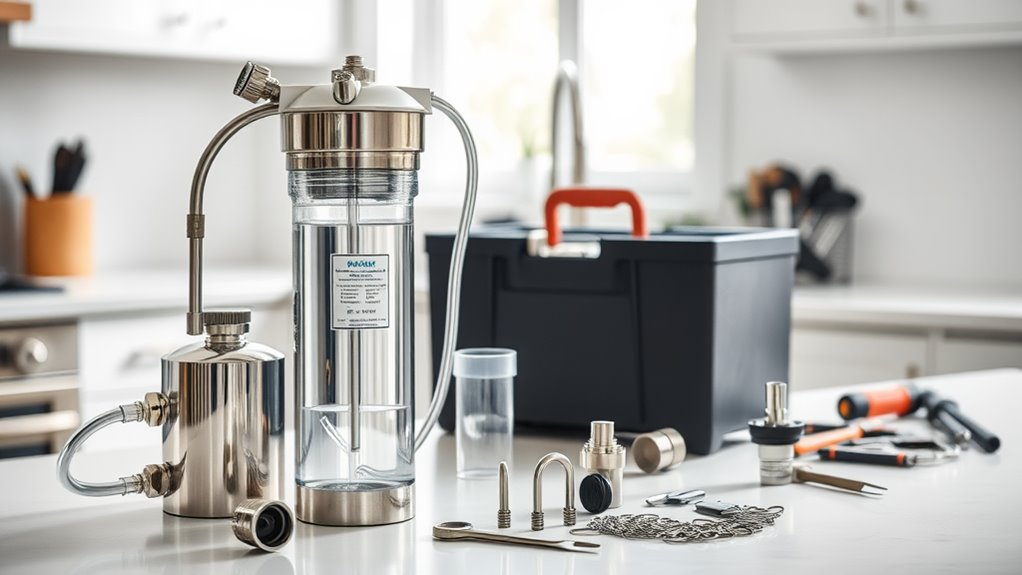
To install a water filter effectively, start by evaluating your water quality and selecting the right filter type. Gather necessary tools and materials, then choose an accessible location for installation. Shut off the main water supply and drain the lines. Cut the water supply lines cleanly, solder any connections, and add shutoff valves. Once everything's securely connected, check for leaks before restoring water supply. Understanding maintenance needs is essential, and there's more to explore for peak performance.
Installing an effective water filter can greatly improve your home's water quality, guaranteeing you and your family have access to clean, safe drinking water. To start, you'll need to assess the contaminants present in your water supply. Evaluate for sediment, chemicals, and other impurities that could affect your health. Once you identify these contaminants, you can choose the right type of filter. Depending on what you find, you might opt for a carbon filter to eliminate chlorine or a reverse osmosis system for broader purification.
Installing a water filter enhances your home's water quality, ensuring safe drinking water for your family by addressing specific contaminants.
If you're unsure about the contaminants or what filter to select, consider consulting with water quality experts or a licensed plumber. They can provide tailored advice based on your specific water conditions and needs. Regular testing of your water quality is essential too; it guarantees that your chosen filter continues to perform effectively over time. Familiarizing yourself with local water quality regulations and standards can also guide your decisions and guarantee compliance.
When it comes to selecting the right filter, think about the categories available. Whole-house filters, installed at the main supply entrance, provide a thorough solution for all water used in your home, while under-sink filters serve specific points of use. Evaluate the cost of these systems and weigh it against potential long-term savings on health and maintenance. Additionally, consider that different systems may have varying installation requirements that could impact your choice.
Also, consider the maintenance needs of different filters; some require frequent cartridge replacements, while others may have a longer lifespan. Researching the effectiveness of various filters against specific contaminants and checking customer reviews can also help in making an informed decision.
Choosing an appropriate installation location is vital. For whole-house filters, position them near the main water supply to optimize flow. If you're going for an under-sink installation, verify there's adequate space beneath the sink. Accessibility is key; you want to make sure you can easily reach the filter for maintenance and cartridge changes.
Verify that the filter system is compatible with your existing plumbing setup to avoid complications. Leaving room for potential future upgrades can also save you from additional labor later on.
Before you begin installation, gather the necessary materials. Basic tools like an adjustable wrench, plumber's tape, and Teflon tape should be in your toolkit, along with specialized parts such as saddle valves and T-adapters. Make sure all filter components, including cartridges and housings, are included. A power drill may be needed for installing a faucet, and appropriate sealants will help prevent leaks.
Start your installation by shutting off the main water supply. Open faucets to drain the lines and clean the pipes thoroughly to prevent contamination. Wear protective gear, like gloves, to safeguard against accidental splashes. Take photos or diagrams of your existing plumbing setup for reference during the installation process.
When you're ready, use a tubing cutter for clean cuts in the main water supply lines. Solder connections safely away from the filter housing, apply flux, and guarantee you add shutoff valves for maintenance convenience.
Finally, securely connect the tubing to the filter system and check for any leaks before turning your water supply back on. Following these steps will guarantee you install an effective water filter that meets your family's needs for clean and safe drinking water.
Conclusion
By following these steps, you're ensuring crystal-clear water flows from your tap, like a rejuvenating mountain spring. Each connection you tighten and every filter you install brings you closer to pure hydration. Picture yourself sipping that clean, cool water, free from impurities, revitalizing your body. You've not just installed a filter; you've created a safe haven for your family's health. So, take pride in your work—clean water is within your reach, ready to nourish and rejuvenate.
